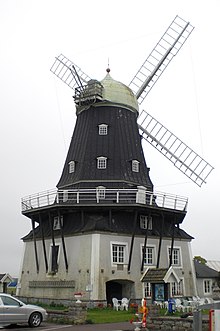Sandviks Kvarn
Sandviks Kvarn (dt. Sandviker Mühle ) is a Dutch windmill in Sandvik on the Swedish island of Öland in the Baltic Sea . It is the largest windmill in Northern Europe.
history
Sandviks Kvarn was built in Vimmerby on the Swedish mainland in 1856 . After damage to the wings, it was initially no longer used as a mill, but for other purposes. It was sold in 1885. The buyer had the entire mill dismantled. The numbered parts were brought to Sandvik and rebuilt here on a two-story plinth made from Öland limestone .
In contrast to the so-called Stubb mills that were widespread in Öland and were usually only operated for household needs, the Sandviker mill was a wage mill . In 1909, the mill buyer's son took over the eight-story mill and ran it until the 1950s. Originally there were entrances on the ground floor both on the east and west side through which horse-drawn vehicles could drive directly into the mill for loading and unloading. The sacks of grain were taken directly from the car to the fifth floor with an elevator. The miller's apartment was also in the mill. The apartment on the south side of the ground floor was converted into a workshop over time, and in 1926 it was converted into an engine room for a crude oil engine .
The local homeland association bought the mill in 1955 and opened a simple cafe. In 1964 the kitchen in the former machine room was modernized and the cafe expanded into a restaurant. Another modernization took place in 1978.
Function and structure
The eight-story mill building has a height of 26 meters, the distance between the tips of the mill wings is 24 meters. The floor space, without the kitchen, is 140 m².
The ground floor was used for the delivery and delivery of goods and originally contained the miller's apartment. On the second floor above, the finished flour was sifted and filled into sacks. Later on, three millstones were also built here for an engine operation. The third and fourth floors were also screened. The actual grinding process took place on the fifth floor. There are five pairs of millstones here. Each pair weighs about three tons. Three of the pairs were made of hewn limestone , another of volcanic rock , and the fifth of cast iron . The foundations of the grinding plant are on the fourth floor. The distance between the millstones could be set exactly to a few hundredths of a millimeter.
The technology for the elevators and the insertion of new millstones was located on the sixth floor.
As with all Dutch windmills, the top part of the mill at Sandviks Kvarn can be rotated to adapt to the changing wind directions. In the otherwise predominantly on Öland common on the type of windmills genbauten mills the entire mill is rotated. On the seventh floor is the ring gear on which the top eighth floor can rotate. The turning in the wind took place via a chain from the outer circuit. The brake on the eighth floor could also be controlled in this way.
The crown gear is on the seventh floor and is connected to the axis of the windmill blades. The wheel, which is 3 meters in diameter, transfers the wind power into the mill. Here, too, there is a braking device to be able to stop the wings. Both the crown gear and the drive screws have a paternoster thread carved from wood .
Originally the wings of the mill were covered with canvas . Later, however, it was converted to wooden gates that could be adjusted from the circulation even during operation .
Web links
Coordinates: 57 ° 4 ′ 20.5 ″ N , 16 ° 51 ′ 39 ″ E
